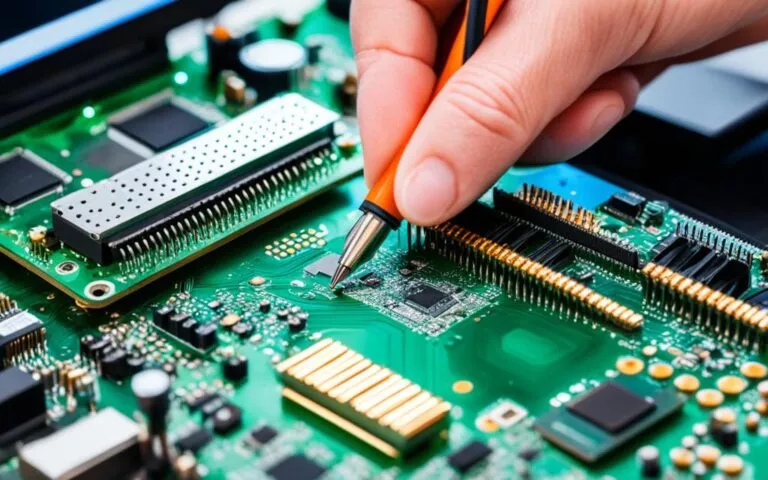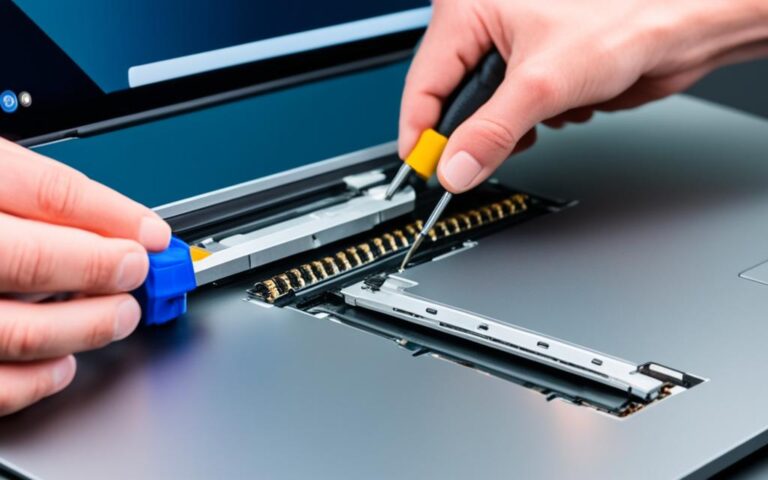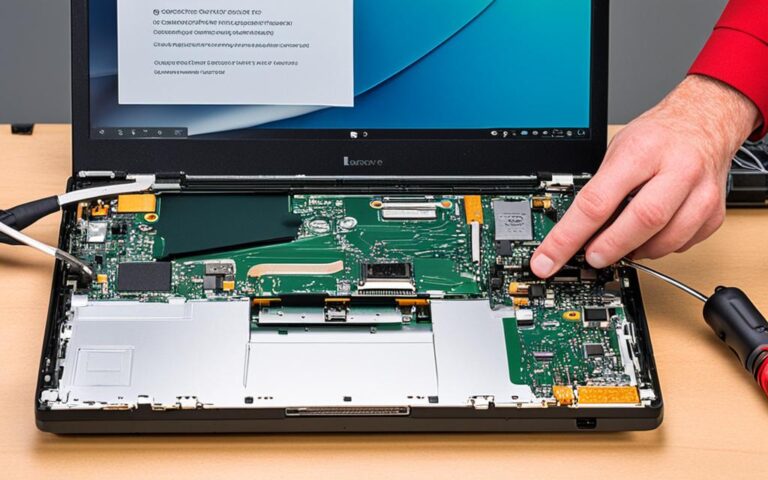Comprehensive Guide to Diagnosing Laptop Motherboard Failures
Diagnosing laptop motherboard failures can be a daunting task, with motherboard problems often presenting themselves in various ways. It’s essential to troubleshoot motherboard failure accurately, as it can mimic other issues and lead to unnecessary repairs.
Some common symptoms of motherboard failure include the laptop not turning on, freezing during use, running slower than usual, and malfunctioning keyboard or touchpad. These issues can severely impact your productivity and the overall performance of your laptop.
In this comprehensive guide, we will explore the causes of motherboard failure and provide troubleshooting steps to identify and resolve these issues. Whether you are a tech enthusiast or a laptop user facing motherboard problems, this guide will equip you with the knowledge to diagnose and resolve laptop motherboard failures effectively.
Symptoms of Motherboard Issues
Since the motherboard is connected to all other components in a laptop, issues with it can be difficult to diagnose. Common symptoms of motherboard failure include:
- Laptop not turning on: Even when fully charged, the laptop fails to power up, indicating a potential motherboard problem.
- Incomplete booting: The laptop starts but fails to complete the boot process, suggesting a faulty motherboard.
- Frequent freezing during use: If the laptop frequently freezes or crashes while in operation, it could be a sign of motherboard issues.
- Slower performance: A noticeable decrease in the laptop’s speed and overall performance could be attributed to a failing motherboard.
- Unusual noises: Strange noises emanating from the laptop, such as beeps or clicks, may indicate motherboard problems.
- Malfunctioning components: Issues with the keyboard, touchpad, or other hardware components can also be attributed to a faulty motherboard.
These symptoms can often be mistaken for other issues, underscoring the importance of properly diagnosing motherboard problems.
Causes of Motherboard Failure
There are several factors that can contribute to motherboard failure in a laptop. Understanding these causes can help in preventing potential issues and prolonging the lifespan of the motherboard. The main causes of motherboard failure include:
- Power Surges: Power surges, which can occur during thunderstorms or when plugging or unplugging the laptop from a power source, can cause significant damage to the motherboard and other components. The surge of electrical energy can overload and short-circuit sensitive circuits, leading to malfunction or complete failure of the motherboard.
- Overheating: Overheating is another common cause of motherboard failure. It typically arises due to an accumulation of dust and debris within the laptop or a malfunctioning cooling system. When the laptop overheats, it puts additional stress on the motherboard and other components, causing them to degrade over time. High temperatures can also lead to solder joint failures, capacitor leakage, or even warp the motherboard.
- Physical Damage: Drops, impacts, and other physical damage can also result in motherboard failure. The delicate circuitry of the motherboard can easily be damaged by external forces, leading to connectivity issues, short circuits, or even complete component failure. It is crucial to handle laptops with care and provide adequate protection to prevent physical damage.
- Age: As with any electronic component, age plays a significant role in the degradation of the motherboard. Over time, the various electronic components on the motherboard begin to wear out, resulting in reduced performance and increased chances of failure. The constant heating and cooling cycles, as well as the natural aging process of electronic components, can lead to weakened connections, capacitor breakdown, and other issues.
By understanding these common causes of motherboard failure, laptop users can take proactive measures to minimize the risk and ensure the longevity of their devices. Regular cleaning, proper cooling, and careful handling can go a long way in preventing motherboard issues.
It is important to note that while these causes are commonly associated with motherboard failure, each situation may differ. Seeking professional assistance is recommended if you encounter any issues with your laptop’s motherboard to accurately diagnose and resolve the problem.
Troubleshooting Motherboard Failure
When faced with motherboard failure, it is essential to follow a systematic approach to diagnose and resolve the issue. Troubleshooting motherboard failure involves a series of steps aimed at identifying the cause of the problem and finding appropriate solutions. By following these common troubleshooting steps, you can effectively diagnose motherboard issues and take necessary action.
- Check for Power: The first step is to ensure that the laptop has a power source. Connect it to a power outlet or try a different power cable to rule out any power-related issues.
- Attempt to Boot Up: Press the power button and observe if the laptop boots up. If it does not turn on, proceed to the next step.
- Run Diagnostic Tests: Use diagnostic software or system tools to perform tests on the motherboard. These tests can highlight any error messages or issues that may be causing the failure.
- Review Event Log: Check the event log for any error messages or warnings related to the motherboard. These logs can provide valuable information about the underlying problem.
- Inspect for Physical Damage: Open up the laptop and visually inspect the motherboard for any signs of physical damage. Look for any dust or debris buildup that may be obstructing the proper functioning of the motherboard components.
- Reseat RAM and Check Connections: Remove and reinsert the RAM modules to ensure they are properly seated. Additionally, check all the connections, such as cables and connectors, to ensure they are securely attached.
In case all the troubleshooting steps fail to resolve the motherboard failure, seek professional help from experienced computer repair experts. They have the expertise and tools needed to diagnose the exact cause of the failure and recommend appropriate solutions.
Testing the Components
When diagnosing motherboard failure, it is essential to test the components connected to it. This step helps identify faulty components and determine the cause of the motherboard failure. Several tools can be used to perform these tests, providing valuable insights into the health of the motherboard and its associated components.
One of the most commonly used tools for testing motherboard components is a multimeter. This device measures voltage, current, and resistance, allowing you to assess the electrical characteristics of various components. By testing the voltage supplied to different parts of the motherboard and the resistance across specific components, you can pinpoint potential issues.
Another useful tool for testing motherboard components is a POST card. This card is inserted into an available slot on the motherboard and displays power-on self-test (POST) codes. These codes provide valuable information about the status of the components during the booting process. By interpreting these codes, you can identify problematic components and narrow down the cause of the motherboard failure.
In some cases, utilizing a spare computer can also aid in diagnosing faulty components. By swapping out suspect parts and observing the behavior of the spare computer, you can determine whether a specific component is causing the motherboard failure. This method can be particularly effective when dealing with non-essential components such as graphics cards or expansion cards.
When testing the components, it is crucial to disconnect non-essential components and focus on the core elements of the motherboard, including the CPU, RAM, and power supply. Observing any lights, sounds, or display activity during the testing process can provide valuable clues about the faulty component. Additionally, systematically testing each component one by one can help isolate the problematic element.
In summary, testing the components connected to the motherboard is an important step in diagnosing motherboard failure. Using tools such as a multimeter, POST card, or a spare computer can help identify faulty components and determine the cause of the failure. By following a systematic testing approach and paying attention to signs and symptoms, you can effectively diagnose and resolve motherboard issues.
Replacing or Repairing the Motherboard
Once the motherboard failure has been diagnosed, the next step is to decide whether to replace or repair the motherboard. While replacing the motherboard is generally simpler, it can be more expensive and time-consuming. Repairing the motherboard may involve soldering, reflowing, or replacing damaged components such as capacitors, resistors, or chips. However, it requires advanced skills and equipment and may not guarantee a successful outcome. When replacing or repairing the motherboard, it is important to find a compatible replacement or a reputable repair service. It is also crucial to back up data and settings before proceeding.
If you opt for motherboard replacement, ensure that the new motherboard is compatible with your laptop model. Check the specifications and consult the manufacturer’s documentation or customer support to ensure a proper fit. Additionally, consider purchasing a new or refurbished motherboard from a reliable source to ensure quality and compatibility.
If you choose to repair the motherboard, it is essential to have the necessary skills and experience in soldering and component replacement. Alternatively, you can seek professional assistance from a reputable computer repair service. Make sure to inquire about their expertise in motherboard repair and their success rate in similar cases.
Repairing the motherboard can be a delicate process and may not always be successful. It requires careful handling of delicate components and specialized tools. If you are not confident in your skills or lack the necessary equipment, it is best to consult a professional.
In either case, before proceeding with motherboard replacement or repair, it is crucial to back up all your important data and settings. This ensures that even if something goes wrong during the process, you won’t lose valuable information.
Pros and Cons of Replacing and Repairing the Motherboard
| Replacing the Motherboard | Repairing the Motherboard |
|---|---|
| Pros: | Pros: |
| 1. Simpler process | 1. Potential cost savings |
| 2. New and up-to-date components | 2. Preserves the original motherboard |
| 3. Warranty on the new motherboard | 3. Can retain customizations and settings |
| Cons: | Cons: |
| 1. Expensive | 1. Advanced skills required |
| 2. Time-consuming | 2. Success not guaranteed |
| 3. Risk of compatibility issues | 3. Potential for further damage during repair |
Replacing or repairing a motherboard is a critical decision that depends on various factors, including cost, skill level, and the overall condition of the laptop. Consider the pros and cons of each option, and if in doubt, consult a professional to ensure the best possible outcome for your laptop.
Considerations for Motherboard Failure
When faced with motherboard failure, there are several factors to consider. In some cases, it may be more cost-effective to replace the entire computer rather than spend time and money diagnosing and repairing individual components. However, repurposing old tech can be a sustainable option for certain situations, especially when considering e-waste and product lifecycles. It is important to evaluate the overall condition of the laptop and weigh the costs and benefits of replacement versus repair.
Conclusion
Diagnosing and troubleshooting motherboard failures can be a challenging task due to the complex nature of the component and the wide range of symptoms it can cause. However, by carefully considering the symptoms, potential causes, and conducting systematic testing, it is possible to identify and resolve motherboard issues.
Whether replacing or repairing the motherboard, it is important to take into account factors such as cost, time, and the overall condition of the laptop. While replacing the motherboard may seem like the easier option, it can be more expensive and time-consuming. On the other hand, repairing the motherboard requires advanced skills and equipment, but it may not guarantee a successful outcome.
Seeking professional help when needed is crucial in diagnosing and troubleshooting motherboard problems. Computer repair experts can provide expert guidance and ensure the best course of action for resolving motherboard issues.
FAQ
What are the common symptoms of motherboard failure?
Common symptoms of motherboard failure include the laptop not turning on, freezing during use, running slower than usual, and malfunctioning keyboard or touchpad.
What are the causes of motherboard failure?
Power surges, overheating, physical damage, and age are common causes of motherboard failure.
How can I troubleshoot motherboard failure?
To troubleshoot motherboard failure, check for power, run diagnostic tests, look for physical damage or overheating, and consider reseating RAM or loose connections.
How can I test the components connected to the motherboard?
Several tools can be used for testing, including a multimeter, a POST card, or by swapping and testing components on a spare computer.
Should I replace or repair the motherboard?
The decision to replace or repair the motherboard depends on factors such as cost, time, and the overall condition of the laptop. It is recommended to seek professional help in making this decision.
What are the considerations for motherboard failure?
Considerations for motherboard failure include evaluating the overall condition of the laptop, weighing the costs and benefits of replacement versus repair, and considering repurposing old tech as a sustainable option.
How do I conclude the process of diagnosing motherboard failures?
By carefully considering the symptoms, potential causes, and conducting systematic testing, it is possible to identify and resolve motherboard issues. Seeking professional help when needed can provide expert guidance and ensure the best course of action for resolving motherboard problems.












